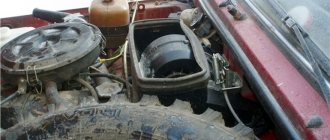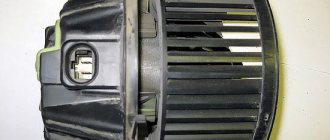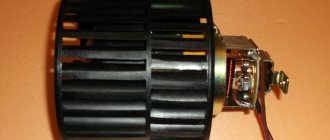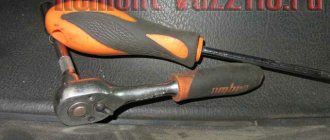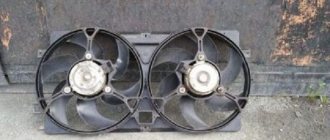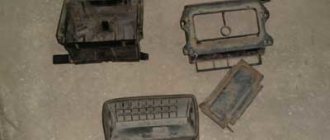Every modern person knows the proverb given to us by our ancestors that it is useful to prepare a sleigh in the summer. However, it is not always possible to carry out some types of repair work on time if you own a car. Often the vehicle itself “manages” this process. As soon as something knocks or creaks, you immediately begin to look for the problem. In the same way, the first news of help from the heater fan on your VAZ-2108 begins to arrive. It is not difficult to guess why it is precisely at the moment of the first frost that car owners most often have to face such a problem. It’s just that the days before were hot and warm, so no one even tried to turn on the stove.
So, if the heater motor on your VAZ-2108 howled pitifully and sadly, don’t hesitate, but start carrying out repair work. Of course, many G8 owners don’t even know what actions are important to take to restore the device to excellent performance. In order not to torment you with unnecessary doubts, and not to force you to spend time searching for the necessary information, we are ready to present you with a step-by-step algorithm of actions. If you follow it, you will be no worse than a real master in carrying out repairs, after which the heater fan on your VAZ 2108 will work flawlessly and successfully compete with new devices.
Fan replacement process
Of course, you should prepare for any task; only in these cases can you count on an optimal result. It is imprudent to purchase any spare parts or the new motor itself in advance, since no one knows what the problem is, why the heater motor on your VAZ-2108 howled so much. However, to carry out diagnostics it must first be removed. For these specific actions, you will need to have a Phillips screwdriver, a 10mm socket and a ratchet handle on hand. We will work both from the engine compartment and from the interior.
Algorithm of actions
First, open the hood and unscrew the five bolts that securely secure the plastic trim. We remove it and put it aside so that it does not interfere with us during all subsequent actions. Now remove the rubber seal on the hood as it prevents the fan guard from being removed. As soon as you remove this casing, you will immediately be able to find the motor itself. It is easy to see that it is fastened with two bolts. Arm yourself with a pre-prepared screwdriver and unscrew these bolts.
After this, we suggest that you move into the car interior and prepare to continue working in an uncomfortable position. It is very important to disconnect the power leads. Under the instrument panel you will find a positive wire plug, unplug it. The next step should be to disconnect the negative wire. However, it is additionally secured with a nut located in an inaccessible place. For this reason, try to initially feel it, and then, after getting used to it, unscrew it using a socket and ratchet. Once you disconnect the wires, push them towards the motor itself. Leave the interior and go to the engine compartment again. Grasp the engine with both hands and carefully turn it from side to side to find the optimal location to remove it.
After you manage to remove the heater motor, inspect it to make sure it is intact and free of mechanical damage. If your diagnostics show that the stove motor can no longer be restored, go to the store and buy a new one. You really don’t want to part with some money, but you still have no other choice. It is impossible to travel without a heater in winter, not only because there is no comfort, but also because such trips are unsafe.
Some craftsmen are making efforts to remake a failed motor. If the bushings on the VAZ or UAZ heater motor “fly”, many decide to insert bearings instead. Indeed, it is possible to revive the fan’s operation, but especially not to get rid of the noise. Only you can decide for yourself whether to purchase a new one or restore the old one; we are not your guide in this matter. In any case, you will also have to perform steps aimed at installing a new or restored motor back into the engine compartment. Don't worry about this because you will have to do the same thing, just in reverse order.
So, as you can see, removing and then installing a new motor on the stove of your “eight” is not an difficult task. It is quite enough to carefully familiarize yourself with the algorithm we have proposed and carry out all the steps flawlessly.
FakeHeader
Comments 19
Judging by the ties, you didn’t find the original block. The funny thing is that the same block goes to the trunk release button (0_o)
But I can’t buy this lubricant ANYWHERE (((It seems like a necessary thing, but it’s not available anywhere (
What didn’t you like about lithol? =) And liquid moth with a special type for contacts, they gave it to me))) It’s a necessary thing, contacts don’t like to oxidize)))
I want a special one))
You need to want and desire a woman, but it is recommended to lubricate the contacts)))))
There was a similar story, but with wipers. Natural poltergeist! I went on business one day, the glass was dirty, I thought, “Now I’ll turn on the windshield washer for a couple of seconds and that’s it...”, yeah... That’s not the case! The wipers rose, stood across the glass and... that's it... I drove off about 50 meters... Reverse, go home. I sprayed the glass with a bucket, turned it off, turned on the ignition - the wipers returned to their place... Hmm... Well, to hell with it, I drove off. It’s drizzling, I turn on the wipers - zero emotions... I arrived at my destination and thought “shozacher?” I looked at the front - it was burnt... I changed it, turned on the wipers and... There was a bang in the fuse block, a cloud of smoke! I turned off the ignition, went to pull out the front, pulled out the melted plastic, burned my fingers... F***, I think I’ve never seen anything like this before... I put another before, with trembling hands I turn it on - zero emotions... I take out the front - burnt. But it burned without any special effects - quietly. I put another pred - again zero emotions, but it no longer burns out, although the pred turned out to be 7.5 amperes. And as luck would have it, every day I was running around from morning until night, there was no time to eat and go and... all these days there were terrible downpours! The rear wiper only works! Oh, what a point... When it finally came time for repairs, I took it apart and sat on my ass! In the block on the side of the wires are the remains of a charred... small bug! The wire that supplies “+” to the wiper motor has MELTED at the base! I cut off the block at the root, threw it in vinegar for a day, then soldered new wires to the terminals in the block, insulated it with heat shrink, filled it with engine oil, twisted it with the cut off standard wires, all this in electrical tape and heat shrink, corrugation and heat shrink again. It worked. But I'm not happy. You need to buy new terminals, solder them, splice them with the original wiring, also by soldering, and inject sealant into the terminal from the wire side. To be sure!
What is a stove fan
A car heater, which is popularly called a stove, is designed to perform a simple and at the same time important function - heating the interior. In addition, the device helps eliminate fogging of windows in cold and damp weather. During normal operation of the heating system, the temperature in the interior of the “nine” should be maintained at +20 ˚С with the same indicators outside, but only with a minus sign. In the legs, with maximum heating mode, the value should be maintained at +25 ˚С. One of the important components of the stove, in addition to the radiator, is the fan. The purpose of this device, its malfunctions and repairs should be considered in more detail.
Purpose of the device
The purpose of the motor is to increase the efficiency of the heating system and air circulation in the car. Its operation is based on air intake from outside and its subsequent supply into the cabin through the radiator. As a result of the air flow passing through the heat exchanger, the air enters the cabin already warmed up.
Heater operation diagram: a - VAZ 2108; b - VAZ -2108–01: 1- fan impeller; 2 — air duct for heating the windshield; 3 — windshield heating flap; 4 — damper for heating the driver’s feet; 5 — central nozzle flap; 6 - central nozzle; 7- radiator; 8 — heater control damper; 9 — driver’s foot heating window; 10 - internal ventilation duct
Where is the motor located on the VAZ 2108/09
The heater motor on the VAZ 2108/09 is installed in a niche in the engine compartment in front of the windshield, which is radically different from the design of the heater of classic Zhiguli cars, which have a fan installed in the cabin. The unit is an electric motor with an impeller mounted on it, through which air is pumped into the cabin.
The heater motor on the VAZ 2108/09 is installed in a niche in the engine compartment in front of the windshield
Connection diagram
To make it easier to find possible faults with the fan, an installation diagram may sometimes be required, the main components of which are:
- fuse mounting block;
- egnition lock;
- additional resistor;
- fan motor;
- operating mode switch.
The heater motor connection diagram consists of a fuse mounting block, an ignition switch, an additional resistor, a fan motor, and an operating mode switch
Electronic circuit of VAZ 2108, 2109, 21099 with a low device panel
A low device panel was installed on the first VAZ 2109 and a couple of years later it was replaced by the newest “highest” panel. The low panel had virtually no downsides, other than the outdated design and lack of a tachometer. Below is a diagram of the electronic connections for cars with a low panel.
| 1 – block headlight; 2 – electric motor for headlight cleaner (installed on parts of manufactured cars); 3 – engine compartment lamp switch; 4 – sound signal; 5 – electric motor of the engine cooling system fan; 6 – fan motor activation sensor; 7 – generator; 8 – solenoid valve for turning on the headlight washers (installed on parts of manufactured cars); 9 – solenoid valve for turning on the rear window washer (installed on parts of manufactured cars); 10 – solenoid valve for turning on the windshield washer; 11 – spark plugs; 12 – ignition distributor sensor; 13 – ignition coil; 14 – reverse light switch; 15 – cooling water thermometer sensor; 16 – starter; 17 – battery; 18 – brake water level sensor; 19 – switch; 20 – top dead center sensor of the 1st cylinder; 21 – diagnostic block; 22 – carburetor solenoid valve control unit; 23 – starter activation relay; 24 – carburetor limit switch; 25 – carburetor solenoid valve; 26 – sensor for emergency oil pressure warning lamp; 27 – windshield washer motor; 28 – heater fan electric motor; 29 – additional resistor of the heater electric motor; 30 – heater fan switch; | 31 – electric motor for windshield wiper; 32 – cigarette lighter; 33 – backlight lamp for heater levers; 34 – plug socket for a portable lamp; 35 – engine compartment lamp; 36 – glove box lighting lamp; 37 – mounting block; 38 – device lighting switch; 39 – parking brake warning lamp switch; 40 – brake light switch; 41 – steering column switch; 42 – external lighting switch; 43 – alarm switch; 44 – rear fog light switch; 45 – fog light circuit fuse; 46 – rear window heating switch; 47 – side direction indicators; 48 – lampshade; 49 – connector for connecting to a personal lighting lamp; 50 – lamp switches on the door pillars; 51 – ignition relay; 52 – ignition switch; 53 – composition of devices; 54 – switch for the carburetor air damper warning lamp; 55 – rear dimensions; 56 – sensor for level indicator and fuel reserve; 57 – rear window heating element; 58 – electric motor for rear window wiper; 59 – license plate lights; |
Car heating system design
The 2108 heating system consists of the following components:
- draft, which affects the heater valve of the VAZ 2108;
- damper control lever;
- additional resistor;
- a motor that affects the rotation of the fan;
- system operating mode switch.
Heater valve VAZ 2108
Speed control
In order to be able to control the speed of the heater fan, there is an additional resistor located behind the vacuum booster, on the side of the heater. It is equipped with two spirals: the 1st has a resistance of 0.23 Ohm and provides the lowest, 1st fan rotation speed. The second, at 0.82 Ohm, makes it possible to turn on the 2nd speed. If this part is working properly, the driver has the ability to control the temperature in the cabin, lowering it or raising it. If it fails, then there is only one speed left for the heater - the highest. It is the additional VAZ resistor that ensures their switching, except for the last one. Therefore, in fact, the highest one works if it breaks.
Operating principle of the stove
- The liquid is heated to a certain temperature and enters the radiator of the VAZ 2108 stove.
- To ensure constant circulation, rubber tubes are installed between it and the liquid cooling system, fixed for better fastening with clamps.
- Warm air enters the car interior through several openings. The heater motor with its own fan is designed to distribute air evenly.
- The air flows directly to the feet of the driver and passengers, and also exits to the panel. The heat flow is then delayed by the dampers, and therefore the air is cooled. Thus, cool air is supplied to the windshield.
If the operation of the furnace is not satisfactory, it can be modernized. This is done by installing fiberglass.
The action goes like this:
- It is necessary to disassemble the stove, wash all parts and begin assembly. This action can also be used to visually inspect parts for damage. For example, the casing ear often breaks.
- After this, you need to glue all the flaps and fill the seams with sealant. Glue the casing and wait a while until the sealant is stable.
- Assemble the “insides” of the heating system and cover it with fiberglass. Thanks to this, the temperature will increase to 10 degrees.
Other details
The standard heater radiator and thermostat are also replaced. Preference is given to three-row copper radiators. They are more efficient in operation and leak less often. The thermostat is replaced with an analogue one or its thermal insert is modified.
Do-it-yourself modification of the stove on Niva 21213 with your own hands is quite labor-intensive and takes a lot of time. To modify the heating system of this car, you can find ready-made kits on sale that make this work easier. The procedure is presented in the video “Remaking the stove on Niva 21213 with your own hands: video instructions.”
Niva-stove cabin filter and fan motor 2108 are easy to install with your own hands in a Niva VAZ 2121 21213 21214 2131 LADA 4x4 URBAN 21215, 21219, Niva-Bronto, 2129, 21310, Niva-pickup, 21214-M, LADA 4x4 URBAN.
Typical faults
As with any mechanism, problems can occur in the heating system (video author - Andrey Kuzemsky).
If the VAZ 2108 heater motor is broken, you can understand this by comparing some symptoms:
- If the motor does not work when switching operating modes, the cause of the breakdown may be hidden in the resistor. When repairing, you need to replace the resistor with a new one, because it cannot be repaired.
- If the fuse is blown, you need to check the insulation of the armature located on ground. There may be a short circuit.
- If, when switching modes, the VAZ 2108 heater fan rotates at the same speed, this may be a consequence of contamination or oxidation of the collector. In case of repair, it is worth cleaning the collector and, if nothing has changed and the fan continues to act up, you can replace the bearings.
If the VAZ 2108 stove motor does not even show signs of life, then the reason is not in its design, but in a broken circuit. To find out if this is true, you can use a voltmeter.
How to replace
The algorithm for replacing the heater resistor is as follows: 1. It is necessary to remove the negative terminal from the battery; 2. Remove the lining, then the windshield frame trim, remove the upholstery for sound insulation; 3. It is also better to remove the vacuum booster for ease of repair; 4. Disconnect the block with wires located on the resistor; 5. In order not to accidentally replace a device that is still in good working order (after all, the reason may not be in it), it is worth checking it with an ohmmeter, connecting it to the contacts one by one. If there are significant differences from normal readings, then it is necessary to change; 6. To remove a faulty heater resistor, simply unscrew the screw and remove the damaged part; 7. Install the new one in reverse order. Please also note that the block with wires can only be connected in one position.
DIY repair
To carry out repairs yourself, you need to use the following tools:
- a Phillips head screwdriver;
- 10mm wrench.
When dismantling, you need to remove the plastic trim, which is located on the outside of the windshield. To remove it, you need to open the hood and remove the 5 bolts that secure the trim to the body. Remove the rubber seal from the engine compartment and pry the casing with a screwdriver to get to the motor and oven fan. Now you can remove the motor. It is attached to the body of the VAZ 2108 with two bolts.
When the clamps are disconnected, you can turn off the power and disconnect the positive wire of the furnace under the dashboard. The negative one is attached over a special thread and pressed down with a special nut. You need to unscrew the nut by touch and fold back the negative wire. By disconnecting the wires, you can remove the motor and install a new fan. The entire structure is assembled in reverse order.
It is important to note that breakdowns associated with the stove also depend on which panel is installed on the VAZ - low or high. Both have their downsides. For example, on a high one the central flap does not open completely. It is she who is responsible for supplying cold and hot air to the car interior. To solve this, you need to adjust the damper. And to get to it you need to disassemble the dashboard.
If we talk about the low panel, this is where the thermostat often breaks. Of course, if it wears out, the oven will not work. It is recommended to change it every two or three years. And if replacement does not solve the problems, it is worth replacing the hoses that connect the stove and radiator.
Electronic circuit of VAZ-2108, VAZ-2109, VAZ-21099
Electronic circuit of VAZ-2108, VAZ-2109, VAZ-21099 cars. Low device panel.
1 – block headlight; 2 – electric motor for headlight cleaner (installed on parts of manufactured cars); 3 – engine compartment lamp switch; 4 – sound signal; 5 – electric motor of the engine cooling system fan; 6 – fan motor activation sensor; 7 – generator; 8 – solenoid valve for turning on the headlight washers (installed on parts of manufactured cars); 9 – solenoid valve for turning on the rear window washer (installed on parts of manufactured cars); 10 – solenoid valve for turning on the windshield washer; 11 – spark plugs; 12 – ignition distributor sensor; 13 – ignition coil; 14 – reverse light switch; 15 – cooling water thermometer sensor; 16 – starter; 17 – battery; 18 – brake water level sensor; 19 – switch; 20 – top dead center sensor of the 1st cylinder; 21 – diagnostic block; 22 – carburetor solenoid valve control unit; 23 – starter activation relay; 24 – carburetor limit switch; 25 – carburetor solenoid valve; 26 – sensor for emergency oil pressure warning lamp; 27 – windshield washer motor; 28 – heater fan electric motor; 29 – additional resistor of the heater electric motor; 30 – heater fan switch; 31 – electric motor for windshield wiper; 32 – cigarette lighter; 33 – backlight lamp for heater levers; 34 – plug socket for a portable lamp; 35 – engine compartment lamp; 36 – glove box lighting lamp; 37 – mounting block; 38 – device lighting switch; 39 – parking brake warning lamp switch; 40 – brake light switch; 41 – steering column switch; 42 – external lighting switch; 43 – alarm switch; 44 – rear fog light switch; 45 – fog light circuit fuse; 46 – rear window heating switch; 47 – side direction indicators; 48 – lampshade; 49 – connector for connecting to a personal lighting lamp; 50 – lamp switches on the door pillars; 51 – ignition relay; 52 – ignition switch; 53 – composition of devices; 54 – switch for the carburetor air damper warning lamp; 55 – rear dimensions; 56 – sensor for level indicator and fuel reserve; 57 – rear window heating element; 58 – electric motor for rear window wiper; 59 – license plate lights;
A – the order of conditional numbering of plugs in the ignition switch block; B – the order of conditional numbering of the plugs in the windshield wiper motor block.
Source: dricar.ru
